Piecewise Function Hysteretic Model for Cold-Formed Steel Shear Walls with Reinforced End Studs
Abstract
:1. Introduction
2. Construction and Shear Behavior of CFS Shear Wall with Reinforced End Studs
3. Hysteretic Model of CFS Shear Walls with Reinforced End Studs
3.1. Modeling of Backbone Curve
3.1.1. Degradation Analysis of the Lateral Stiffness of the Wall
3.1.2. Discrete Coordinate Method
3.1.3. Determination of Elastic Lateral Stiffness Ke and Shear Capacity Fp
3.2. Hysteretic Model of Load-Displacement Curve
3.2.1. Model Proposition
3.2.2. Modeling of Hysteretic Loop
3.2.3. Criteria for the Dominate Parameters
3.3. Model Verification
4. Summary and Conclusions
- (1)
- Elastic lateral stiffness Ke and shear capacity Fp are key factors determining the load-displacement skeleton curve of a CFS shear wall; where Ke and Fp can be predicted by the equivalent-bracing model and the proposed simplified calculation model, respectively, and the relative errors between their predicted and test results are within 11% and 15%, respectively.
- (2)
- The load-displacement skeleton curves determined by the discrete coordinate method agree well with the test results, which fully reflect the shear behavior (e.g., nonlinearity, stiffness, and strength deterioration) of the walls with reinforced end studs l.
- (3)
- During cyclic loading, test hysteretic curves and the calculated results that were determined by the proposed hysteretic model are of high consistency in both the pinching characteristic and energy dissipating level of the walls. Due to a larger stiffness of the reinforced end studs, the relative error of the total energy dissipation between calculated and test results for 140-type walls is within 10%; whereas, for 89-type walls with reinforced end studs having lower stiffness, both steel frame buckling and a supplementary torsional deformation in screw connections were involved in energy dissipation, resulting in the calculated results being lower than the test results during the later stage of loading.
- (4)
- Several hysteretic models (e.g., Pinching4 material in OpenSees, BWBN model, EPHM, Pivot model, as well as the three-segment nonlinear pinching hysteretic model), were able to reproduce the behavior of the traditional shear wall with coupled C section end studs; in contrast, the proposed piecewise function hysteretic model is suitable for the wall with reinforced end studs (i.e., continuous concrete-filled rectangular steel tube columns), which is more in line with the requirements of mid-rise CFS structures, and the model has intuitional expressions with clear physical interpretations for each parameter.
- (5)
- Due to the significant reduction in cumulative energy dissipation that is caused by insufficient deformation of screw connections, the energy dissipating capacity of a CFS shear wall with reinforced end studs should not be considered when the wall’s aspect ratio is larger (in this study, H/L = 2.5, where H and L are wall height and wall length, respectively).
Acknowledgments
Author Contributions
Conflicts of Interest
References
- Pan, C.L.; Shan, M.Y. Monotonic shear tests of cold-formed steel wall frames with sheathing. Thin-Walled Struct. 2011, 49, 363–370. [Google Scholar] [CrossRef]
- Baran, E.; Alica, C. Behavior of cold-formed steel wall panels under monotonic horizontal loading. J. Constr. Steel Res. 2012, 79, 1–8. [Google Scholar] [CrossRef]
- Lin, S.H.; Pan, C.L.; Hsu, W.T. Monotonic and cyclic loading tests for cold-formed steel wall frames sheathed with calcium silicate board. Thin-Walled Struct. 2014, 74, 49–58. [Google Scholar] [CrossRef]
- Zeynalian, M.; Ronagh, H.R. Seismic performance of cold formed steel walls sheathed by fibre-cement board panels. J. Constr. Steel Res. 2015, 107, 1–11. [Google Scholar] [CrossRef]
- Accorti, M.; Baldassino, N.; Zandonini, R.; Scavazza, F.; Rogers, C.A. Response of CFS sheathed shear walls. Structures 2016, 7, 100–112. [Google Scholar] [CrossRef]
- Gad, E.F.; Chandler, A.M.; Duffield, C.F.; Stark, G. Lateral behavior of plasterboard-clad residential steel frames. J. Struct. Eng. 1999, 125, 32–39. [Google Scholar] [CrossRef]
- Lange, J.; Naujoks, B. Behaviour of cold-formed steel shear walls under horizontal and vertical loads. Thin-Walled Struct. 2006, 44, 1214–1222. [Google Scholar] [CrossRef]
- Mohebbi, S.; Mirghaderi, S.R.; Farahbod, F.; Sabbagh, A.B.; Torabian, S. Experiments on seismic behaviour of steel sheathed cold-formed steel shear walls cladded by gypsum and fiber cement boards. Thin-Walled Struct. 2016, 104, 238–247. [Google Scholar] [CrossRef]
- Fiorino, L.; Iuorio, O.; Macillo, V.; Landolfo, R. Performance-based design of sheathed CFS buildings in seismic area. Thin-Walled Struct. 2012, 61, 248–257. [Google Scholar] [CrossRef]
- Kechidi, S.; Bourahla, N. Deteriorating hysteresis model for cold-formed steel shear wall panel based on its physical and mechanical characteristics. Thin-Walled Struct. 2016, 98, 421–430. [Google Scholar] [CrossRef]
- Kim, T.; Wilcoski, J.; Foutch, D.A. Analysis of measured and calculated response of a cold-formed steel shear panel. J. Earthq. Eng. 2007, 11, 67–85. [Google Scholar] [CrossRef]
- Shamim, I.; Rogers, C.A. Steel sheathed CFS framed shear walls under dynamic loading: Numerical modelling and calibration. Thin-Walled Struct. 2013, 71, 57–71. [Google Scholar] [CrossRef]
- Shamim, I.; Rogers, C.A. Numerical evaluation: AISI s400 steel-sheathed CFS framed shear wall seismic design method. Thin-Walled Struct. 2015, 95, 48–59. [Google Scholar] [CrossRef]
- Zeynalian, M.; Ronagh, H.R. A numerical study on seismic performance of strap-braced cold-formed steel shear walls. Thin-Walled Struct. 2012, 60, 229–238. [Google Scholar] [CrossRef]
- Foliente, G.C. Hysteresis modeling of wood joints and structural systems. J. Struct. Eng. 1995, 121, 1013–1022. [Google Scholar] [CrossRef]
- Nithyadharan, M.; Kalyanaraman, V. Modelling hysteretic behaviour of cold-formed steel wall panels. Eng. Struct. 2013, 46, 643–652. [Google Scholar] [CrossRef]
- Pang, W.C.; Rosowsky, D.V.; Pei, S.; Van de Lindt, J.W. Evolutionary parameter hysteretic model for wood shear walls. J. Struct. Eng. 2007, 133, 1118–1129. [Google Scholar] [CrossRef]
- Huang, Z.G.; Wang, Y.J.; Su, M.Z.; Shen, L. Study on restoring force model of cold-formed steel wall panels and simplified seismic response analysis method of residential buildings. China Civ. Eng. J. 2012, 45, 26–34. [Google Scholar]
- Zhou, X.H.; Yuan, X.L.; Shi, Y.; Nie, S.F.; Zhao, H.J. Research on nonlinear pinching hysteresis model of sheathed cold-formed thin-walled steel stud walls. Eng. Mech. 2012, 29, 224–233. [Google Scholar]
- Ye, J.H.; Wang, X.X.; Jia, H.Y.; Zhao, M.Y. Cyclic performance of cold-formed steel shear walls sheathed with double-layer wallboards on both sides. Thin-Walled Struct. 2015, 92, 146–159. [Google Scholar] [CrossRef]
- Wang, X.X.; Ye, J.H. Reversed cyclic performance of cold-formed steel shear walls with reinforced end studs. J. Constr. Steel Res. 2015, 113, 28–42. [Google Scholar] [CrossRef]
- Xu, Y. Experimental Research on Shear Performance of New-type Cold-Formed Steel Load Bearing Walls; Southeast University: Nanjing, China, 2016. (In Chinese) [Google Scholar]
- Tian, H.W.; Li, Y.Q.; Cheng, Y. Testing of steel sheathed cold-formed steel trussed shear walls. Thin-Walled Struct. 2015, 94, 280–292. [Google Scholar] [CrossRef]
- Chen, C.Y.; Okasha, A.F.; Rogers, C.A. Analytical predictions of strength and deflection of light gauge steel frame/wood panel shear walls. In Proceedings of the International Conference on Advances in Engineering Structures, Mechanics & Construction, Waterloo, ON, Canada, 14–17 May 2006; pp. 381–391.
- Shao, J.H.; Gu, Q.; Shen, Y.K. Analysis of elastic-plastic shear resistance for steel plate shear walls. J. Hohai Univ. (Nat. Sci.) 2006, 34, 537–541. [Google Scholar]
- Fiorino, L.; Iuorio, O.; Landolfo, R. Seismic analysis of sheathing-braced cold-formed steel structures. Eng. Struct. 2012, 34, 538–547. [Google Scholar] [CrossRef]
- Ye, J.H.; Wang, X.X.; Zhao, M.Y. Experimental study of shear behavior of screw connections in CFS sheathing. J. Constr. Steel Res. 2016, 121, 1–12. [Google Scholar] [CrossRef]
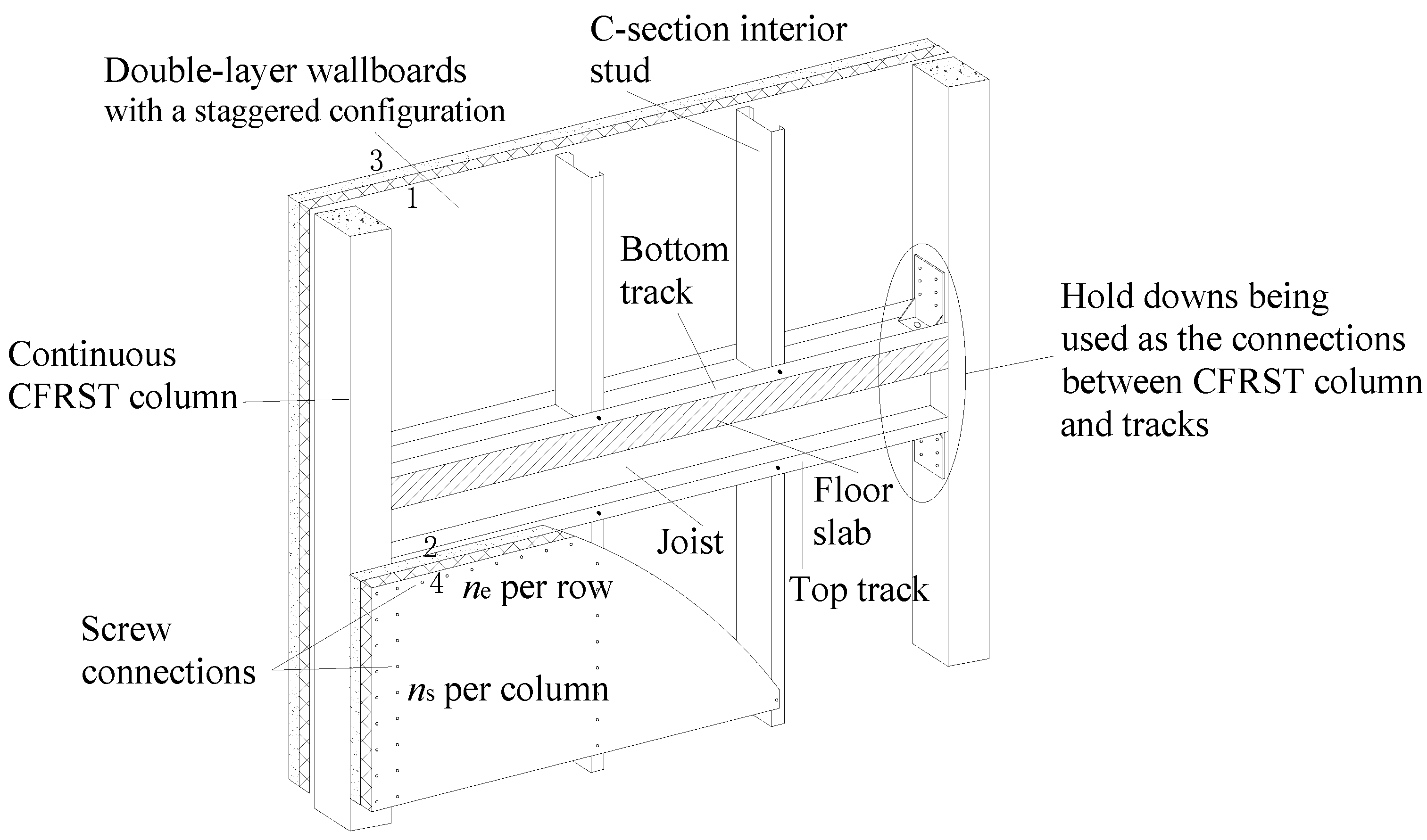
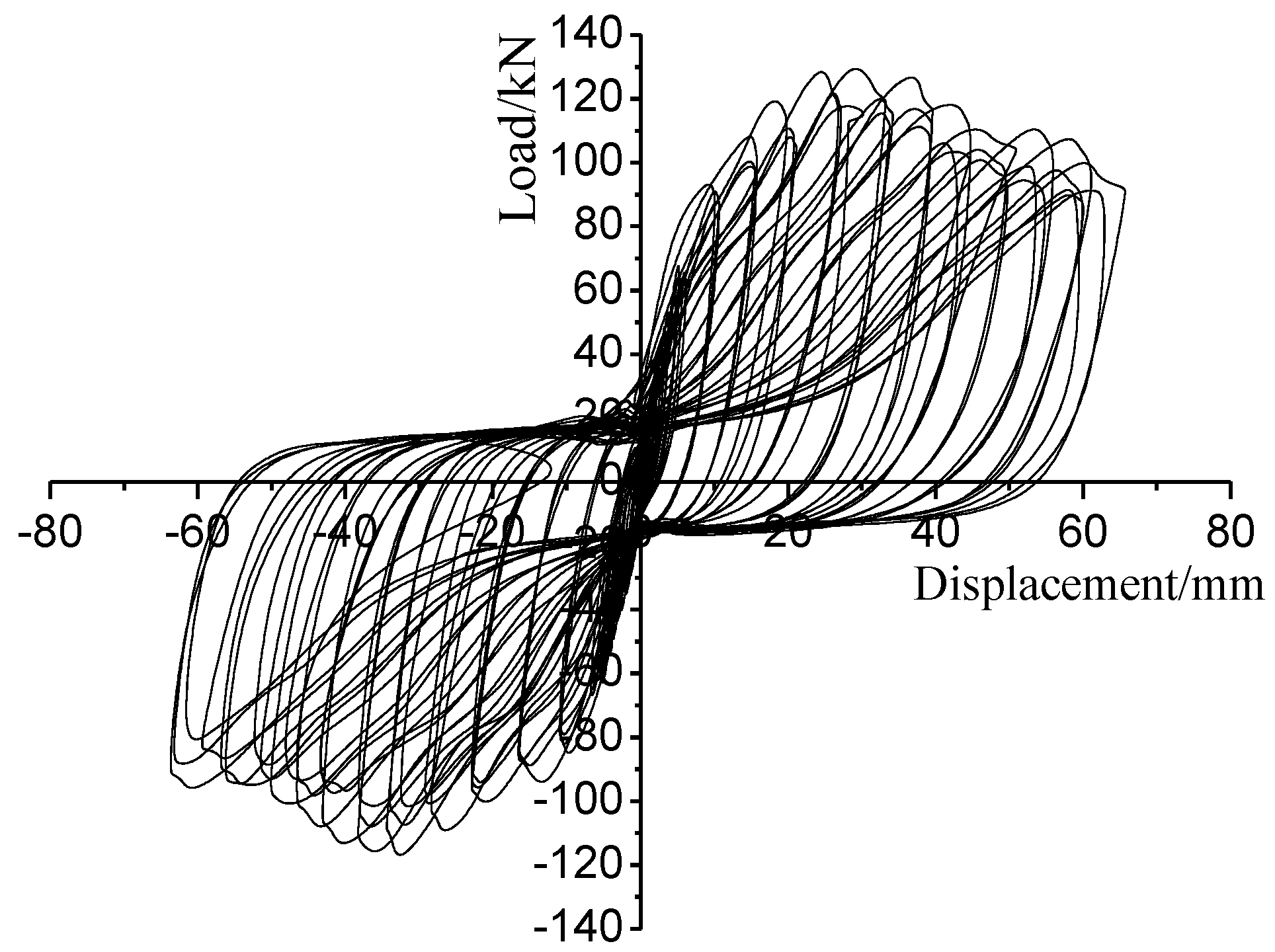
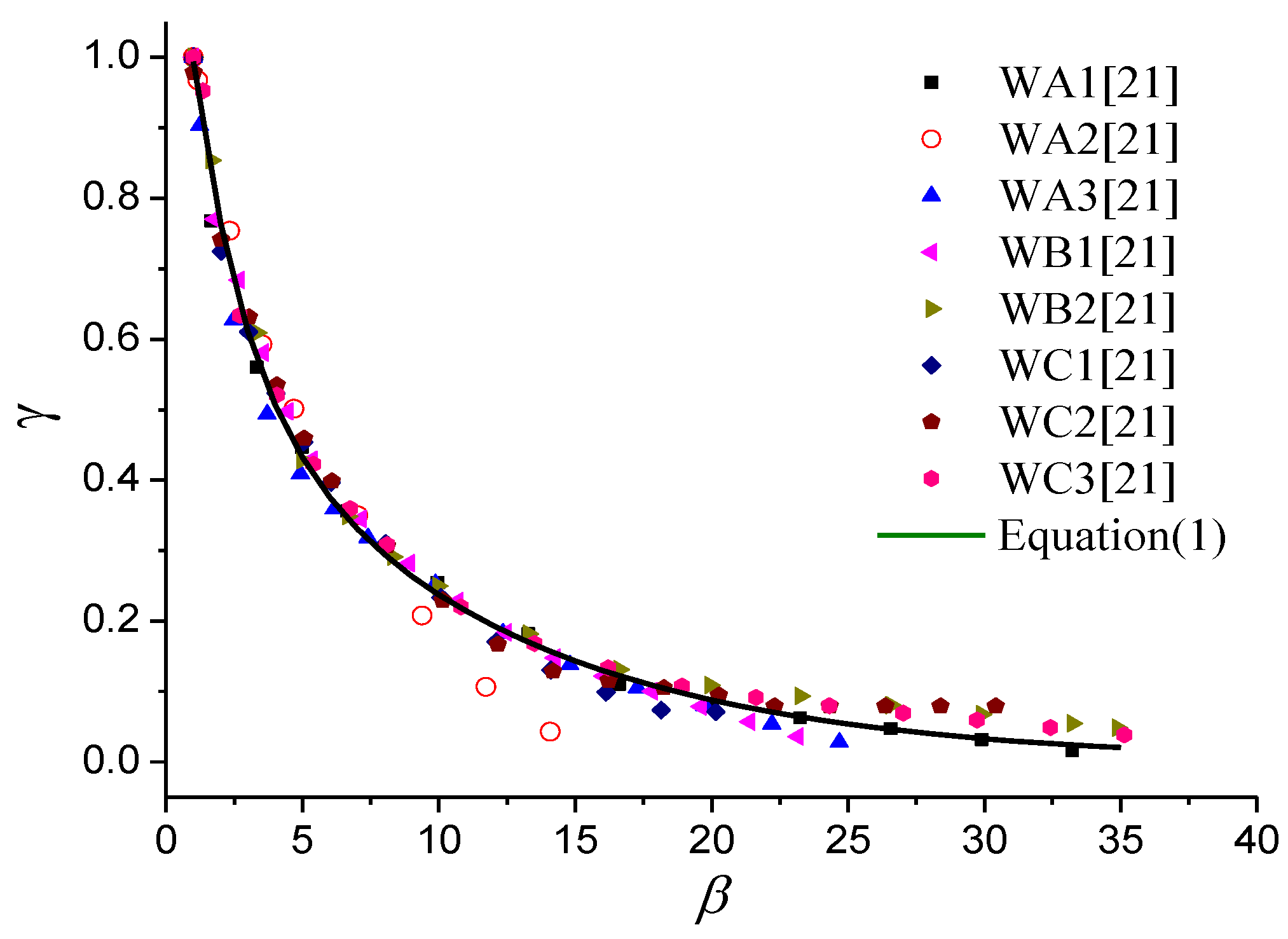
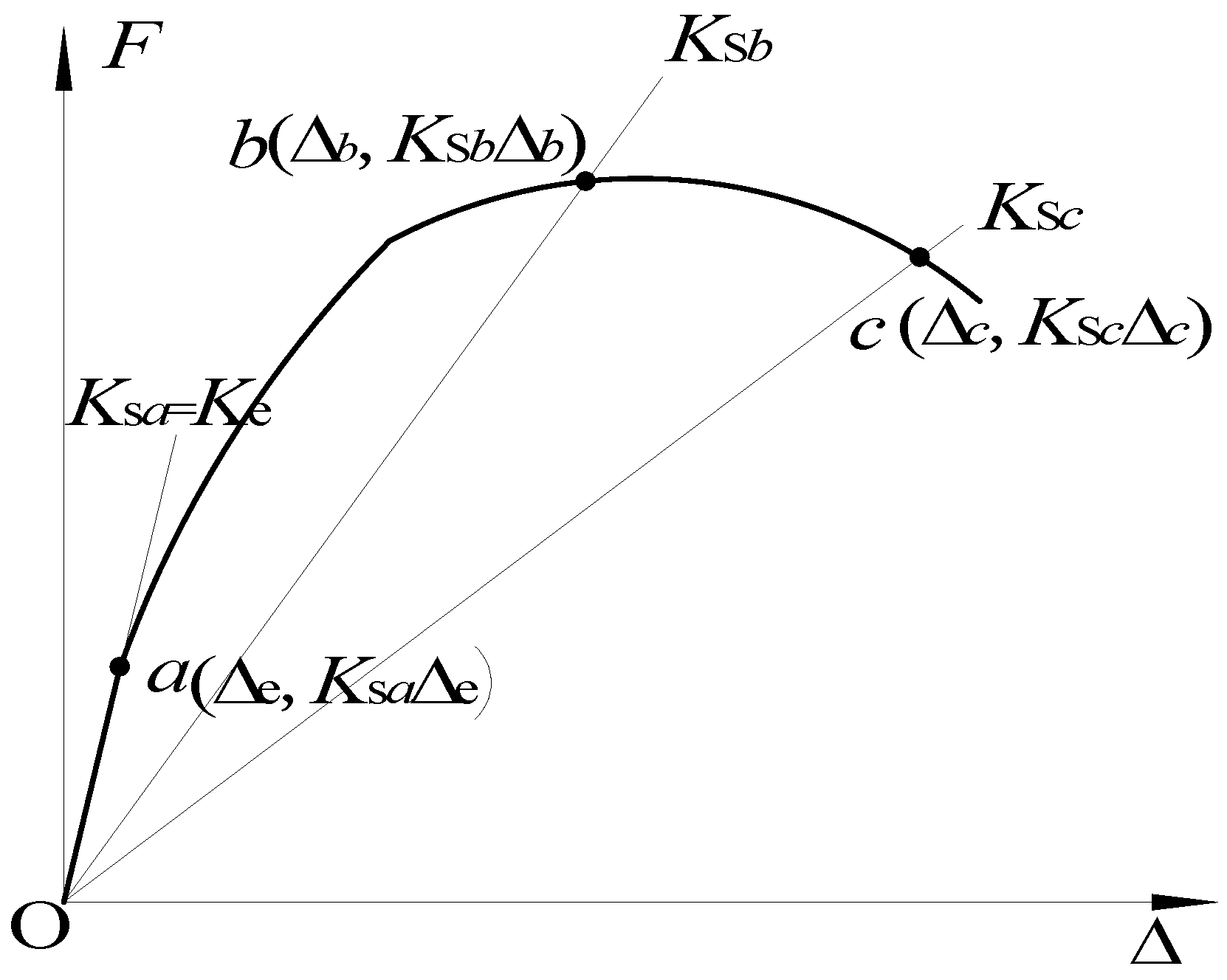
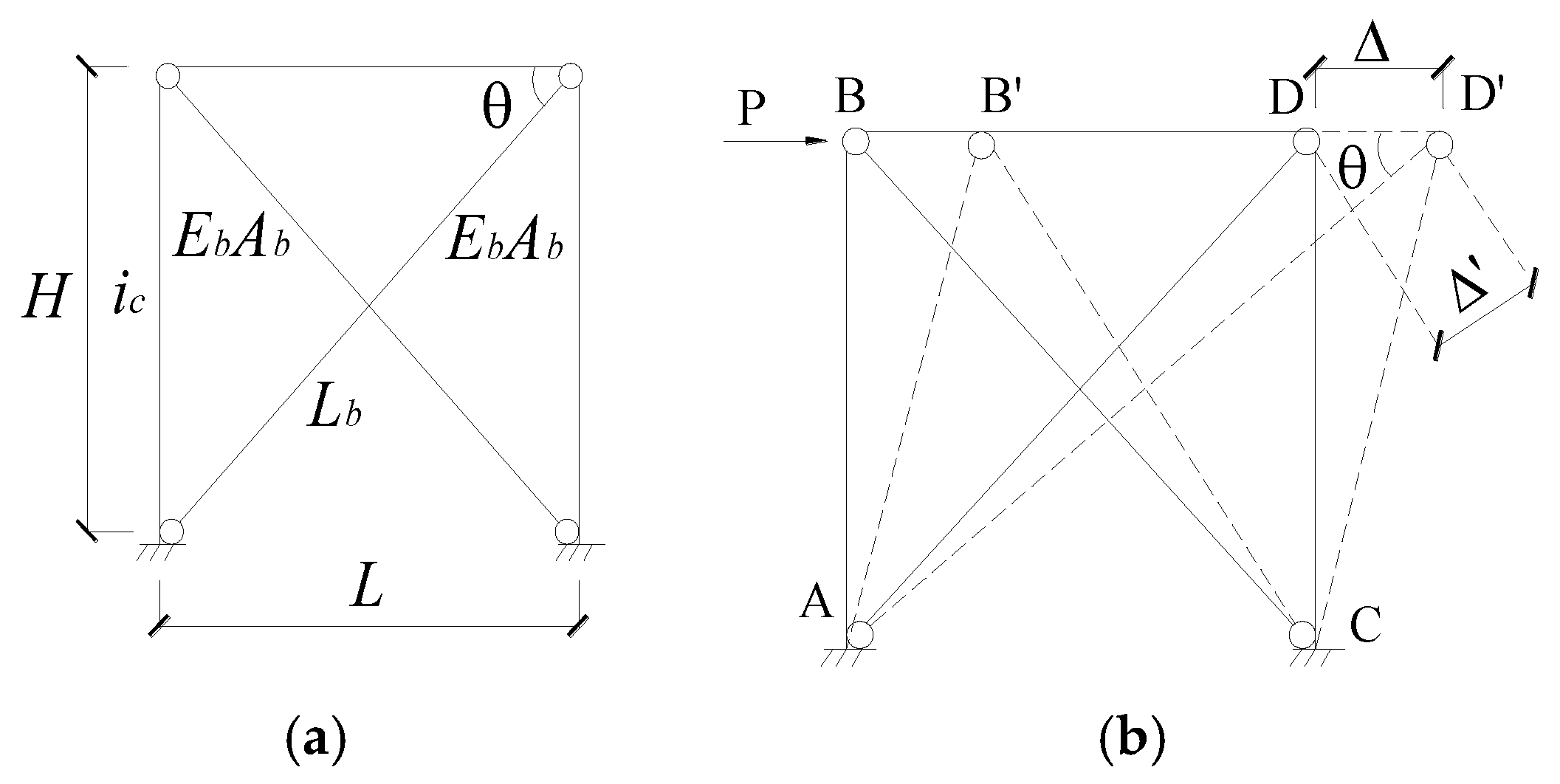
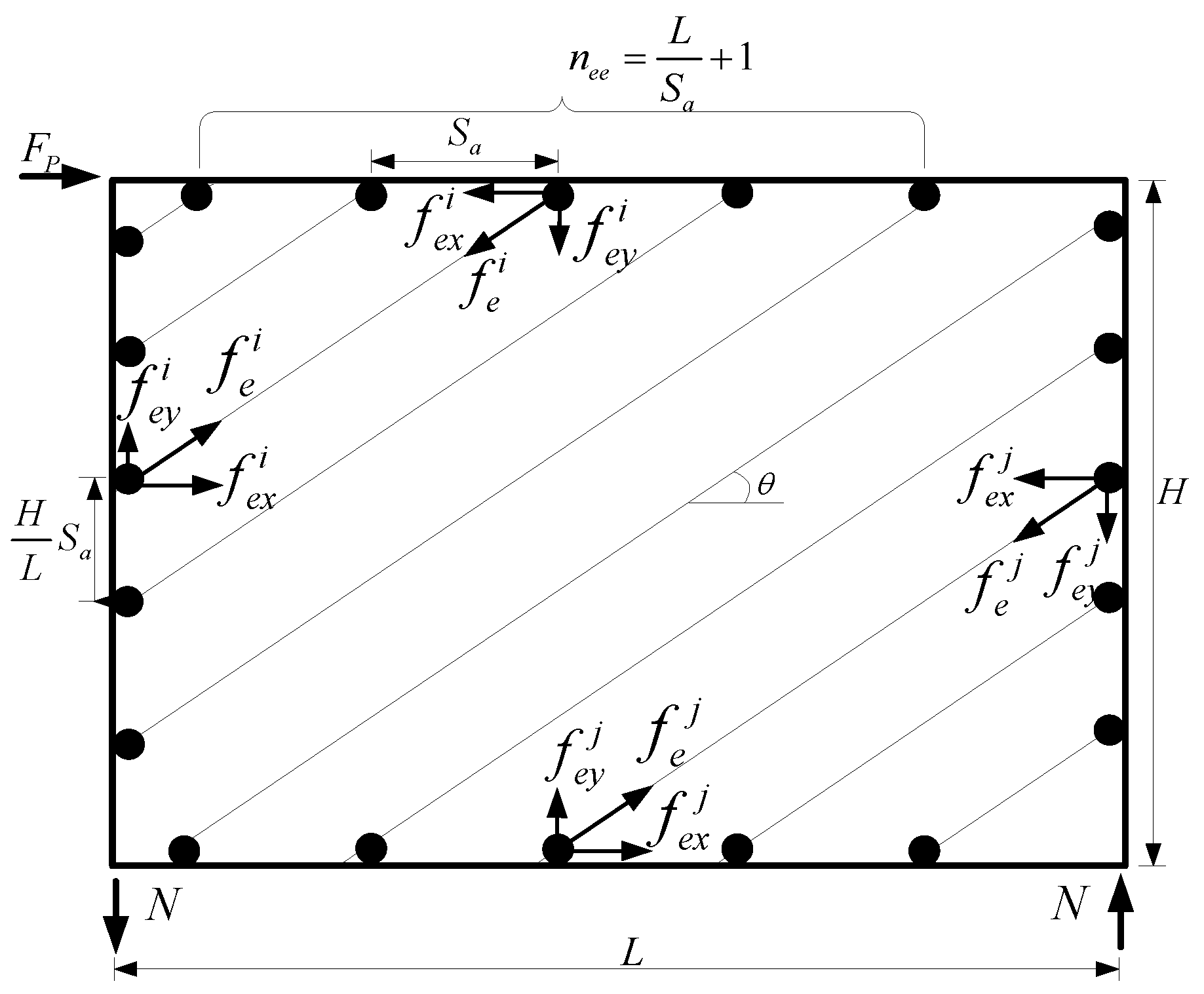
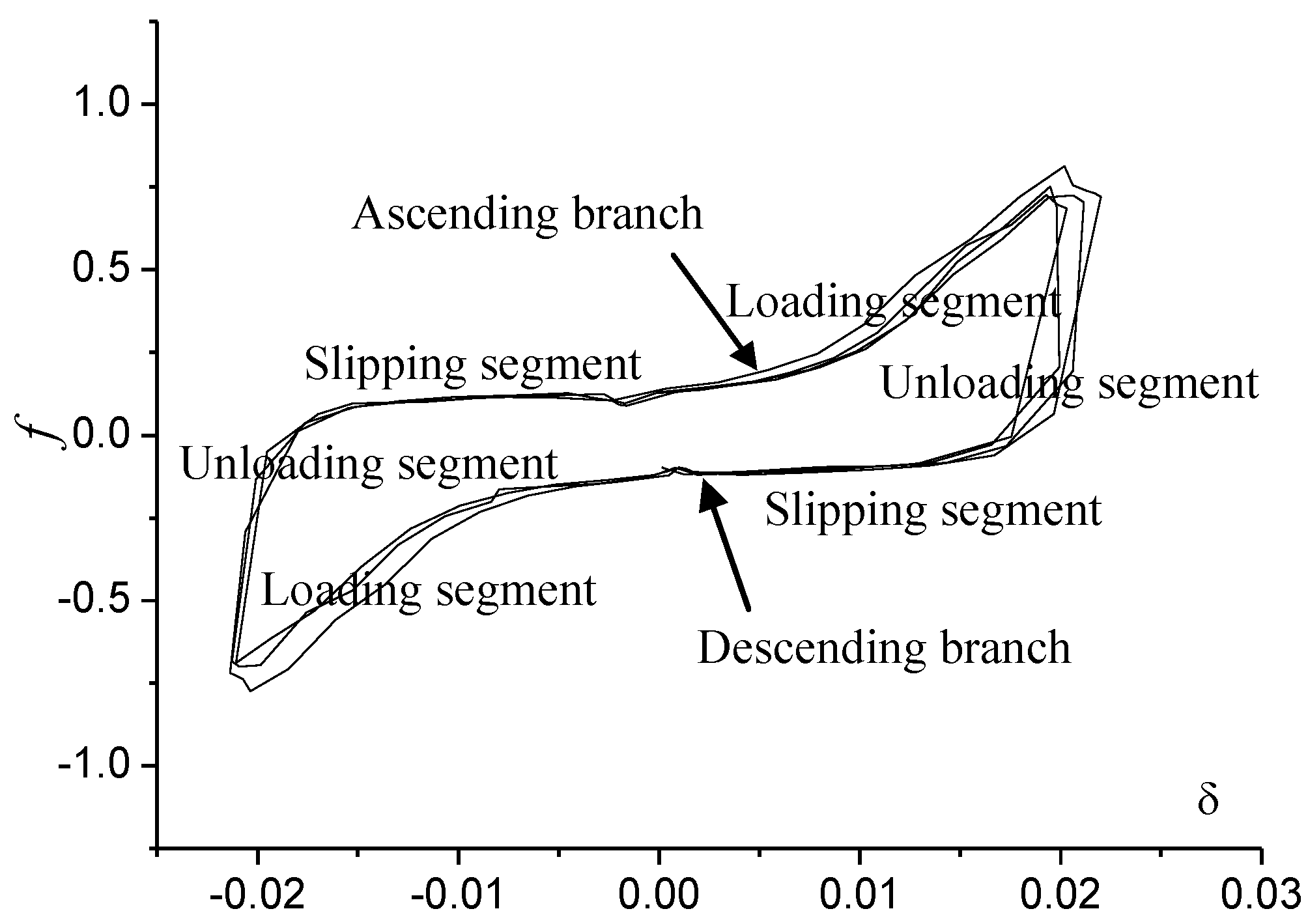
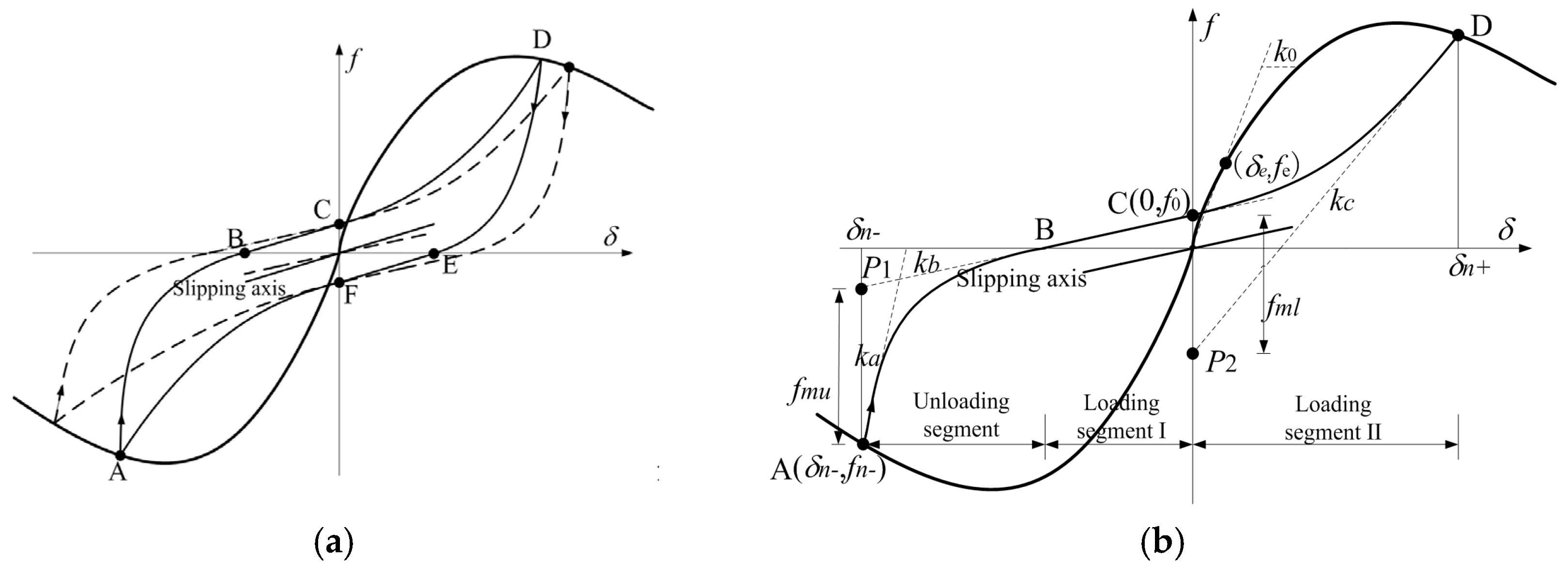
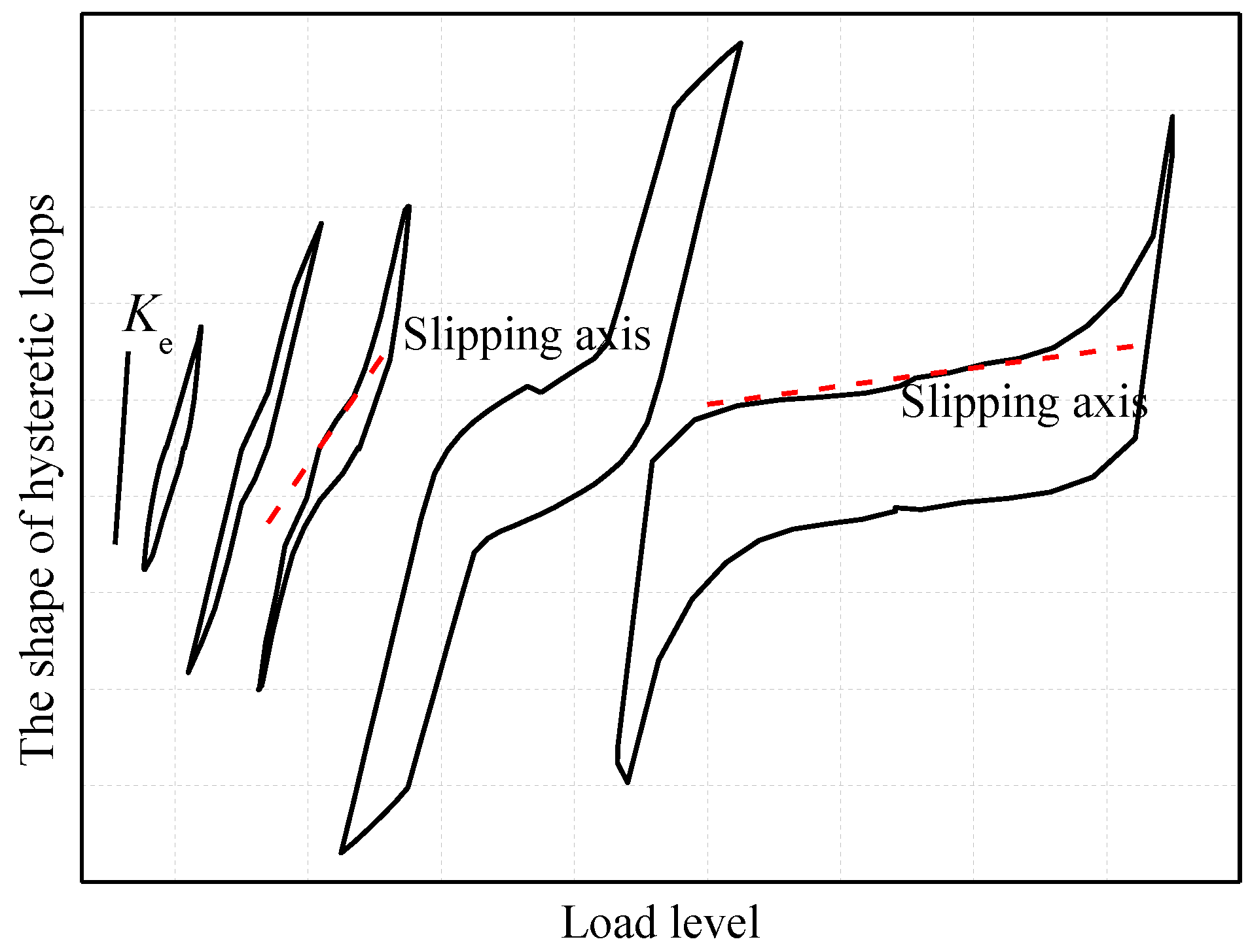
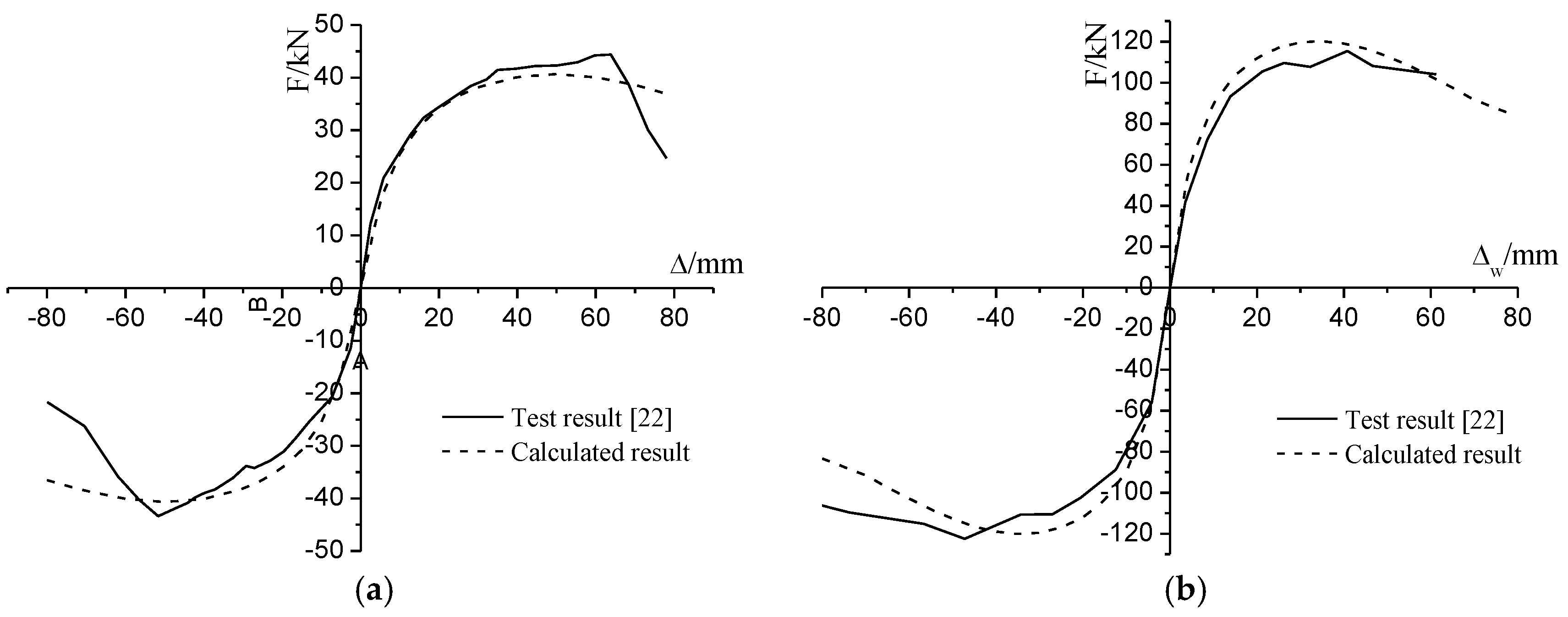

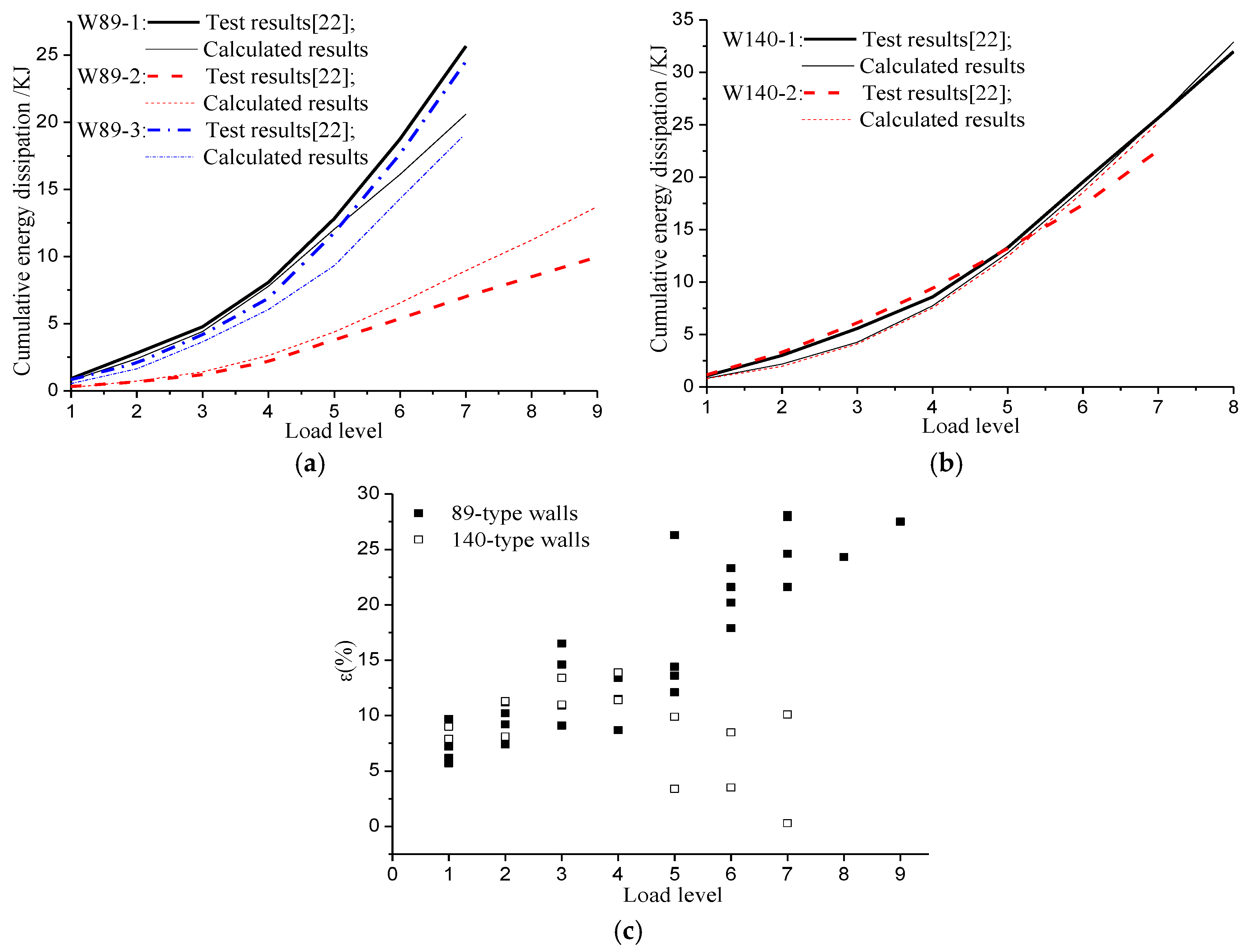
| Specimen Number [21] | Test Results/kN | Calculated Results Based on Elastic Model/kN | Relative Errors |
|---|---|---|---|
| WA1 | 100.0 | 79.7 | −20.3% |
| WA2 | 101.5 | 81.4 | −19.8% |
| WA3 | 109.0 | 81.4 | −25.3% |
| WB1 | 126.5 | 101.5 | −19.8% |
| WB2 | 60.3 | 45.3 | −24.9% |
| WC1 | 109.8 | 70.6 | −35.7% |
| WC2 | 95.4 | 70.6 | −26.0% |
| WC3 | 67.0 | 45.3 | −32.4% |
| Failure Modes | Steel Thickness (mm) | 12 mm Gypsum Wallboard | 12 mm Bolivian Magnesium Board | fe/kN | ||
|---|---|---|---|---|---|---|
| de/mm | f/kN | de/mm | f/kN | |||
| Screw being pulled through | 0.9 | 0.70 | 0.66 | 0.63 | 0.74 | 1.40 |
| 1.2 | 0.62 | 0.73 | 0.50 | 0.70 | 1.43 | |
| Screw being sheared off | - | - | - | - | - | 1.78 |
| Specimen Number [22] | Wall Size/m (L × H) | Elastic Lateral Stiffness Ke (N/mm) | Shear Capacity Fp/kN | Total Energy Dissipation E/KJ | ||||||
|---|---|---|---|---|---|---|---|---|---|---|
| Ket | Kec | κ1 | Fpt | Fpc | κ2 | Et | Ec | κ3 | ||
| W89-1 | 3.6 × 3.0 | 9670 | 10177 | 0.05 | 110.2 | 98.0 | −0.11 | 25.7 | 20.6 | 0.25 |
| W89-2 | 1.2 × 3.0 | 3488 | 3400 | −0.02 | 44.4 | 40.6 | −0.08 | 10.0 | 13.7 | 0.27 |
| W89-3 | 3.6 × 3.0 | 9192 | 10177 | 0.11 | 85.4 | 98.0 | 0.15 | 24.5 | 19.2 | 0.28 |
| W140-1 | 3.6 × 3.0 | 12085 | 11573 | −0.04 | 122.6 | 120.0 | −0.02 | 32.0 | 32.9 | 0.03 |
| W140-2 | 3.6 × 3.0 | 12227 | 11573 | −0.05 | 117.2 | 120.0 | 0.02 | 22.6 | 25.2 | 0.10 |
| Load Case | δn | fn | k0 | ka | kb | kc | fmu | fml | nu | nl | f0 |
|---|---|---|---|---|---|---|---|---|---|---|---|
| 10 mm | 0.0033 | 0.847 | 125.0 | 788.4 | 102.3 | 502.4 | 1.074 | 1.258 | 1.45 | 1.35 | 0.11 |
| 15 mm | 0.005 | 0.948 | 125.0 | 827.3 | 92.0 | 285.6 | 1.298 | 1.050 | 1.40 | 1.40 | 0.11 |
| 20 mm | 0.0067 | 0.998 | 125.0 | 866.2 | 81.8 | 206.2 | 1.436 | 1.041 | 1.35 | 1.46 | 0.11 |
| 30 mm | 0.01 | 1.0 | 125.0 | 941.8 | 61.4 | 148.8 | 1.504 | 1.212 | 1.25 | 1.57 | 0.11 |
| 40 mm | 0.0133 | 0.916 | 125.0 | 1017.3 | 40.9 | 118.7 | 1.350 | 1.317 | 1.15 | 1.68 | 0.11 |
| 50 mm | 0.0167 | 0.791 | 125.0 | 1095.1 | 20.4 | 95.4 | 1.022 | 1.252 | 1.04 | 1.78 | 0.11 |
| 60 mm | 0.02 | 0.657 | 125.0 | 1170.7 | 12.5 | 77.2 | 0.797 | 1.247 | 0.94 | 1.89 | 0.11 |
| Ra | ka0 | Rc1 | Rc2 | Rc3 | Rc4 | Rnu | Rnl | nu0 | nl0 |
|---|---|---|---|---|---|---|---|---|---|
| 22892.0 | 712.8 | 2813.4 | −701.4 | 277.0 | −63.9 | 30.2 | 32.5 | 1.55 | 1.24 |
© 2017 by the authors; licensee MDPI, Basel, Switzerland. This article is an open access article distributed under the terms and conditions of the Creative Commons Attribution (CC-BY) license (http://creativecommons.org/licenses/by/4.0/).
Share and Cite
Ye, J.; Wang, X. Piecewise Function Hysteretic Model for Cold-Formed Steel Shear Walls with Reinforced End Studs. Appl. Sci. 2017, 7, 94. https://doi.org/10.3390/app7010094
Ye J, Wang X. Piecewise Function Hysteretic Model for Cold-Formed Steel Shear Walls with Reinforced End Studs. Applied Sciences. 2017; 7(1):94. https://doi.org/10.3390/app7010094
Chicago/Turabian StyleYe, Jihong, and Xingxing Wang. 2017. "Piecewise Function Hysteretic Model for Cold-Formed Steel Shear Walls with Reinforced End Studs" Applied Sciences 7, no. 1: 94. https://doi.org/10.3390/app7010094





